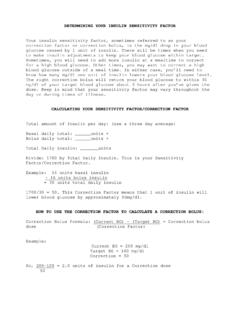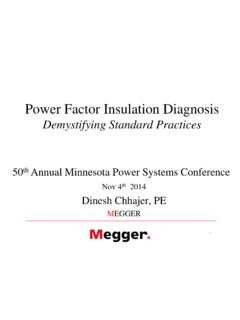Transcription of Glycol Correction Factors - American Chillers and Cooling ...
1 Propylene Glycol Leaving Temperature Degrees F 30% 40% 50% Capacity Factor Pressure Drop Factor Capacity Factor Pressure Drop Factor Capacity Factor Pressure Drop Factor 20 - - 30 40 45 50 55 60 70 Minimum leaving fluid temperature 25 F 10 F -10 F Minimum ambient 10 F -4 F -20 F Ethylene Glycol Leaving Temperature Degrees F 30% 40% 50% Capacity Factor Pressure Drop Factor Capacity Factor Pressure Drop Factor Capacity Factor Pressure Drop Factor 20 30 40 45 50 55 60 70 Minimum leaving fluid temperature 20 F 5 F -15 F Minimum ambients 5 F -9 F -28 F Glycol Correction Factors All Heat exchangers experience a capacity loss when the fluid is a higher specific gravity than water.
2 Glycols are heavy, syrup like fluids at full concentration, and become thinner when mixed with water. However, the mixed solution of water- Glycol will be thicker, heavier, than the water alone was. Thus, to achieve the same heat exchange inside the heat exchanger , requires more surface area or a larger heat exchanger. American Chillers heat exchangers are engineered for full rated capacity with the use of 30% Glycol solutions. Our heat exchangers start out with 30% more surface area capacity than the heat exchangers used by other manufacturers so you still have full capacity with 30% water- Glycol solutions.
3 If you are using Glycol concentrations above 30%, consult factory prior to purchasing your chiller for chiller selection assistance. Glycol Capacities and Correction Tables The charts, above, illustrate the differences between propylene based and ethylene based Glycol . Since we recommend propylene based glycols because of their non-hazardous nature, we must be aware of the effects on the standard refrigeration heat exchangers and pumps. A 40% solution of propylene Glycol will reduce the chiller heat exchanger s ability to chill by at least We know from experience, that some heat exchangers chilling abilities is reduced by 20%.
4 This means the chiller with a 10 ton capacity for chilling water will have a capacity between 8 tons and tons with 40% PG. Most American Chillers have heat exchangers large enough to handle 30% PG without loss of capacity due to our value-added engineering practices. We can easily provide a chiller heat exchanger for even 50% PG at the customer request at time of order.





